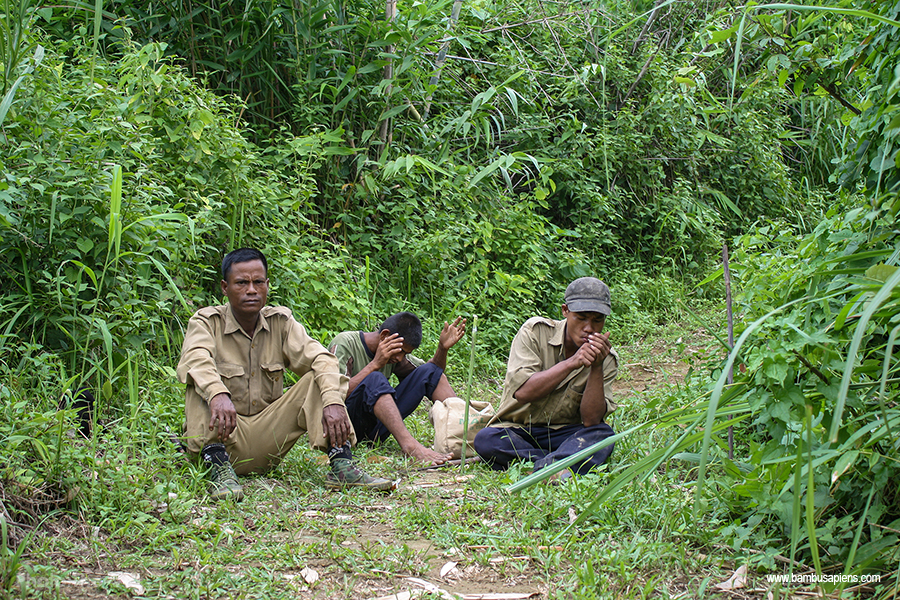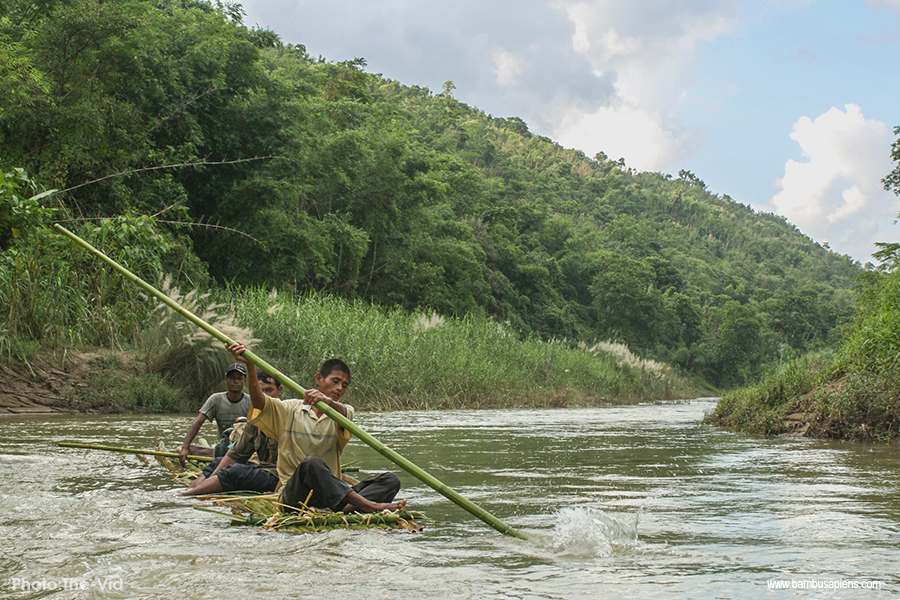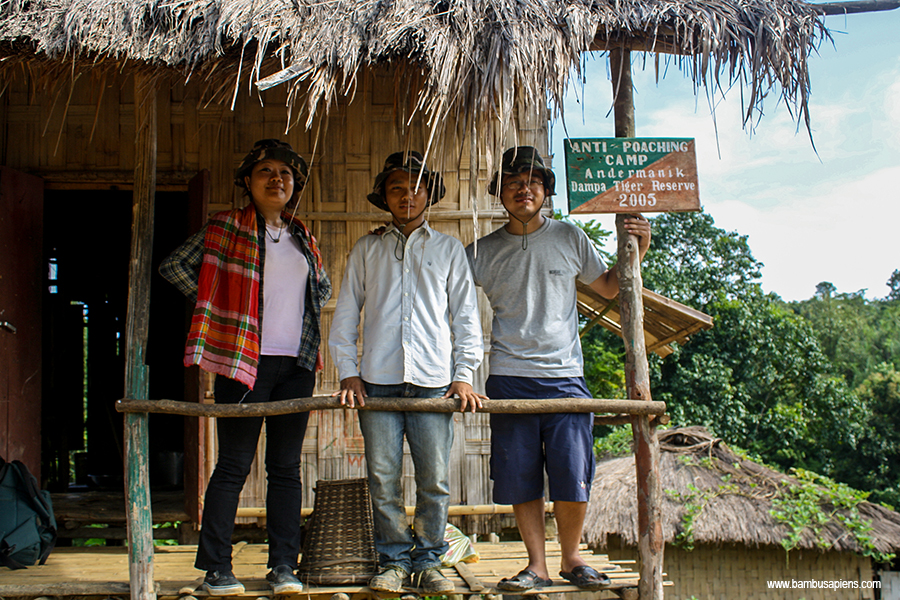Dr David C.Vanlalfakawma | Photo Essay
On September 2009, we were assigned to conduct an Environmental Impact Assessment (EIA) of the proposed Indo-Bangladesh Border Road Fencing, which transects through the Dampa Tiger Reserve (DTR) in the north western part of Mizoram. After a month long preparation, we packed our gears, and headed to Teirei Rest House at Dampa Tiger Reserve. Our team comprised of our Principal Investigator, Mr Laltlanhlua Zathang, ACF; Mr. B. Malsawmkima (B-a); Ms Laldinthari (Madini); and I. At Teirei, we were joined by Wildlife Guards of the Teirei Range.

We were divided into three groups. I was the leader of team 1, that stationed at Sailui. Both team 2 and 3 were stationed at Andermanik Anti-Poaching Camp, and were led by Mr B-a and Ms Madini, respectively. Our mission was to conduct a vegetation analysis along the proposed transect of the Indo-Bangla Border Road fencing.

Our Stay at Sailui Village
From Rajiv Nagar village in Mamit District, we rode a motor-boat till the Sailui Junction, where my team would camp, and the other two teams sailed till the Andermanik village. At Sailui, we fortunately spotted a Jhum hut, which relieved us from constructing a shelter. We stayed at Sailui for two nights; we cooked our own food, and slept on our own beddings, careful not to burden our host, the owner of the jhum hut. As our camping site was outside the Dampa Tiger Reserve core area, anthropological activities were not prohibited.






Our Voyage From Sailui to Andermanik
Andermanik Village ~14 Km from Sailui was, however, within the Dampa Tiger Reserve core area and was about to be relocated, and negotiations were ongoing then. After completing our task along the Sailui-Andermanik transect, we decided to join our friends at the Andermanik Anti-Poaching camp. Instead of taking the normal path, we decided to walk down the Gundasuri stream that drains to the Khawthlangtuipui. Our porter, whom I fondly called “Bondu” led the way, cutting the bushes and clearing the path. The plan was to reach Andermanik by means of a bamboo raft that we had to build from scratch. As we moved down the stream, I could spot several pug-marks.


Bondu was the engineer, Pu Samuel-a and Mapuia helped him collect the bamboo. I could overhear them saying “rawṭhing chu sât suh, a láng ṭha duhlo…” (“don’t cut down rawthing (bambusa tulda), it doesn’t float well”)

After completing our bamboo raft, we tried once, and found that it could not bear our weight. We needed to cut down even more bamboos! As luck would have it, just then, a gentleman from Andermanik appeared, solo-rafting along the river without much belongings. We hitchhiked with him; I rode on his raft, and the other three rode on the raft that we built.



After sometime, he suddenly shouted, “Gui…gui” which left me confused. Later on, I realised that he had spotted a Tuipuisatang (Water Monitor Lizard – Varanus salvator) at a distant shore! To him, it was a nutrition that perished!
After 2 hours of rafting along the Khawthlangtuipui, we finally landed at Andermanik. It was already dark.


They were all surprised to see us at the camp. Since there was no mobile phone signals, and we were also void of radio, we couldn’t inform them

Inside Andermanik, The Village That Fragmented
Prior to its relocation, Andermanik was the only village inside the core area of the Dampa Tiger Reserve. There were ~200 houses, 3 primary schools, six grocery shops and a BSF Duty post. Like other Chakma communities, their main religion was Buddhism and they were solely dependent on Jhumming for their sustenance.

















We stayed at Andermanik for a night and the next day, we left for Rajiv Nagar by foot. It took us around 4 hrs to cover ~ 16.41 Km of steep and slippery paths, up and down the gorges. Knowing the consequences and the biodiversity threats that was awaiting, we proposed that if at all the border have to be fenced, it should be done at the zero boundary, not even an inch inside the Tiger Reserve. Wildlife corridors should be reserved as plenty and wide as possible. We did the best we could. After all, it was our first assignment since leaving the university two months back. When we were approached for this project, our results had not even been declared! But we were energetic and dedicated, and we were satisfied with our efforts, as we had given it our very best.
We tried our best not to impose habitat fragmentation, but it was beyond our power whether the fencing should or should not be constructed. We were told, “It is a matter of national security.” Though the Andermanik Village that fragmented the reserve was relocated, how would a fencing and a motorable patrolling path not fragment the Tiger Reserve?
***
Note From the Editors:
Dear Readers,
We got so immersed in this essay that we felt the need to have more context and updates on the various issues surrounding DTR, which we have added to this essay as below:
Dampa Tiger Reserve (DTR), the largest wildlife sanctuary in Mizoram, was notified in 1985, and declared a Tiger Reserve in 1994. The core area of DTR covers an area of approximately 550 sq kms, with an additional ~500kms buffer zone. There were 13 settlements in the core area at the time of notification of DTR. Beginning from 1989, all settlements have been moved out of the core area, with the last village, Andermanik, relocated in 2011-12.
DTR, located in the Indo-Myanmar Biodiversity Hotspot, houses flora and fauna of high conservation value, and is famed for being home to primates, lesser cats, and forest birds. DTR has its fair share of issues such as poor infrastructure & connectivity, inadequate field staff, shifting cultivation & setting up of oil palm plantations in the buffer areas. In addition to this, DTR abuts Mizoram’s border with Bangladesh and Tripura. A variety of gunmen, from local hunters to armed insurgents regularly traverse the forest. In 2015, independent wildlife biologist, Priya Singh deployed 160 camera traps at DTR, and her cameras revealed photos of armed poachers and insurgents, along with remarkable biodiversity. The cameras themselves were routinely stolen. There have also been numerous instances of kidnapping of construction workers and even the forest guards themselves by these armed insurgents.
As per the report of Management Effectiveness Evaluation (MEE) of Tiger Reserves in India: Process and Outcomes brought out by National Tiger Conservation Authority (NTCA) and Wildlife Institute of India (WII), 2014:
‘DTR has a long international border with Bangladesh, in the west, and Myanmar, in the east. The Bangladesh border is porous, and the 70 km border, which is not fenced yet, is the reason why ‘loot-and-scoot’ activities from across the border are feasible. The rest of the border with Bangladesh is guarded by the BSF.
Fencing should be put in place along the Bangladesh border, over a distance of 62 km, expeditiously to stop infiltration by poachers as this stretch is the only gap in an otherwise completely fenced border.
Dampa is known as a roadless wilderness, but the lack of roads creates problems in day-to-day management.’
Given the above factors, it is not surprising that the international border fencing, along with construction of BSF Border Outposts (BOP) have gone ahead, with 3 BOPS – Chenglui, Kelsam and New Andermanik presently under construction, and construction yet to commence on 2 other BOPS – Zaruma Lui & Nakota. BSF officials have stated that fencing will not cause any effect on wildlife, but rather, for linkage with the wildlife in Bangladesh, wildlife corridors of 100 metres width each will be made in 7 places along the stretch. Despite these assurances, even a layman can assess how devastating their combined effect on the habitat would be. The issue at DTR does, indeed, highlight the challenges of balancing ecosystem preservation with the maintenance of security, especially at a porous international border rife with armed insurgents.
Despite all these challenges, DTR, with its army of passionate forest guards, has continued to thrive over the years. In fact, the first photographic record of a tiger in Dampa Tiger Reserve in seven years was captured just last year by a camera trap set up by veteran conservationist Zakhuma Don, a member of the anti-poaching squad at DTR. Zakhuma is an alumus of Greenhub India and Sanctuary’s own Mud on Boots Project, and was one the winners of The Balipara Foundation Awards, 2017. He is also the inspiration behind writer Sejal Mehta’s children’s storybook ‘Walking in the Wild’. DTR has other prolific forest guards such as hunter turned forest guard Lalvohbika, also a Greenhub India alumnus; and veteran forest guard Kimthanga, one of the eight conservationists across India who was awarded NDTV’s Save Our Tigers Campaign Award. He received his award from Union Minister of State for Environment & Forests, Prakash Javadekar in 2015.
We salute these brave conservation warriors, and hope to have the chance to travel there, and showcase their works in the future. In the meantime, check out these beautiful videos shot by the forest guards themselves who have created a breathtaking repository of natural history images and videos with their limited equipments.
We thank Dr David for allowing us to publish this remarkable photo essay, and hope you enjoyed this journey with us.
Sincerely,
The Editors
_________________________

Dr David C. Vanlalfakawma is an ecologist and conservationist whose research and areas of interest range from climate change mitigation and carbon sequestration to ecosystem ecology, regeneration and restoration ecology, and sustainable development. He was a National Post-Doctoral Fellow under SERB-DST (2017-2019), and presently teaches at the School of Earth Sciences and Natural Resources Management, Mizoram University. He is also a prolific hobby photographer, and blogs at Bambu Sapiens.
_________________________
Find The Mean Journal on Instagram @MeanPepperVine


